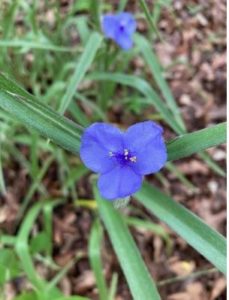

by Lydia Holley May 24, 2021
Dotted along roadsides and in garden settings, spiderworts (Tradescantia) are now in bloom. Their blue color is prized by gardeners, but you need to wake early to enjoy them because by afternoon, their flowers will have closed.
There are several types of spiderworts, many of which are native to the United States and a few native to East Texas. Not all spiderwort blooms are blue. Some are purple, pink, or even white. Some will change color according to soil pH, like a hydrangea. There are spiderworts which take full sun to part shade and others which grow in part to full shade. All will multiply freely.
Spiderwort is not an especially alluring name, and different sources give varying reasons for this plant’s unusual common name. Lady Bird Johnson Wildflower Center says the name is because, “The angular leaf arrangement suggests a squatting spider.” Missouri Botanical Gardens, however, takes a more scientific approach, stating, “When the stems of spiderworts are cut, a viscous stem secretion is released which becomes threadlike and silky upon hardening (like a spider’s web).”
Too bad this plant does not have a more flattering common name. If it did, it might be used more. Although its lack of use might also be contributed to its small bloom, or the foliage which dies back later in the year.
A different type of Tradescantia with a prettier common name is T. pallida, which you may know as purple queen or purple heart. It is not planted for its bloom, but for its striking purple foliage. You may also know T. zebrina, commonly known as inch plant, wandering spiderwort, or wandering Jew. Its leaves are green with stripes, although it turns purple in brighter conditions. Then there is T. spathacea, known as Moses-in-the-cradle, boat lily, or oyster plant.
Not a Tradescantia, but a flower which looks very similar to spiderworts are dayflowers (Commelina), also commonly known as widow’s tears. Like spiderworts, there are several types of dayflowers with bright blue flowers. However, the blooms are so small, despite their enticing color, they are often overlooked or considered weeds.
For more information, call 903-675-6130, email hendersonCMGA@gmail.com.
Follow us on Facebook: https://www.facebook.com/HCmastergardener.